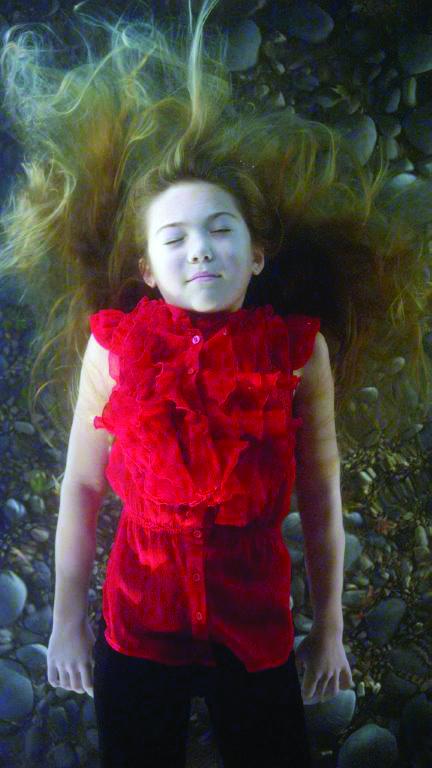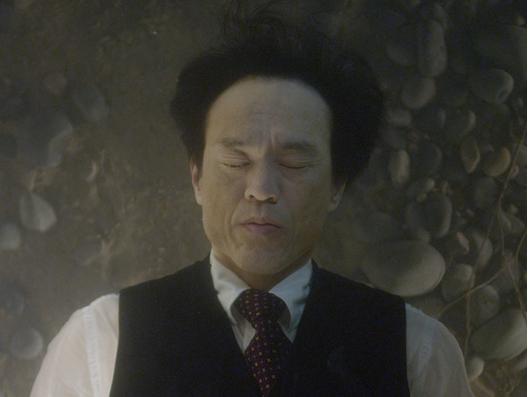Projected on high-definition video screens, seven fully clothed people of different ages, genders and ethnicities float beneath the surface of a river or lake. The rippling water is so crystal clear that you can see the rounded pebbles strewn beneath them. Eyes closed, barely moving, are they dreaming or are they drowning?
It’s impossible not to react to Bill Viola’s “The Dreamers” on view at the Academy Art Museum through March 1. Sequestered in a darkened gallery partitioned off from the rest of the museum by a shadowed hallway, it is a place apart where the ordinary rules are suspended. The room is filled with a low underwater rumble, and there’s a scary moment when you first walk in and feel you’re surrounded by drowned bodies. But then you notice a shining pearl of air escaping a nostril or a hand ever so slowly opening.

Detail of “The Dreamers,” 2013 by Bill Viola, seven channels of high-definition video on seven 65” plasma screens with four channels of stereo sound
Once again, the Museum is to be applauded for exhibiting art that is not only beautiful but also timely and deeply thought provoking. Viola has rightly been called the grandmaster of American video. In his 40-year career, he has done much to establish video as a vital art form in synch with contemporary culture and technology. Building on a keen interest in both eastern and western art and in Buddhism, Sufism and Christian mysticism, he explores how sense perception shapes our consciousness of self and the world.
Tiny changes are the first clue to Viola’s aims. A hand slowly moves up toward a heart; shifting emotions play across a dreamer’s face. There’s a slight smile, a touch of worry, a shadow of a frown, yet the overall feeling is one of calm and introspection. As the light shimmers through the water that gently cradles them, it becomes more and more clear that these seven dreamers are deep in reflection.
Although ostensibly anonymous, they are each highly individual. Following in the tradition of the old masters, Viola has created portraits that pointedly incorporate the distinctive attributes of clothing, hair and facial features of each of these very different people. Augmented by the rippling light and clarity of the water, these singular details with their gemlike colors and rich darks and lights oddly recall the compelling qualities of a painting by Vermeer or Rubens.
There’s a lot you can tell about these individuals, and it’s fascinating to puzzle out their stories whether it’s a well-groomed Asian businessman with an air of intelligence and capability tempered by the weight of responsibilities, a man in a saffron yellow shirt with mala beads and only a stubble of hair, or a scamp of a girl wearing a ruffled red blouse whose long tresses billow Ophelia-like all around her.
But while it’s intriguing to speculate on personalities and circumstances, Viola’s work is never superficial. Different as they are, it’s clear that these people share the same situation, alone and vulnerable in their watery dreaming.
It’s Viola’s genius that he can turn a terrifying thing like drowning into a mesmerizing meditation on how we react to the isolation of introspection. In a culture bent on constant stimulation, looking inward is not high on the list of preferred activities. While we often long for peace and quiet, it can be uncomfortable or even scary to be alone with one’s self.
In enticing the viewer to slow down and look closely, Viola’s work sensitizes the eye and opens the mind to the richness and variety of human experience. Gently, it teases you into something approaching the dreamers’ state of deep contemplation. What you find there can be surprising. The almost embarrassing intimacy of seeing each of the dreamers so exposed unmasks similar feelings within ourselves. Individuality opens into universal experience. The separate self melts into unbounded awareness.
Viola’s work plays with the curious parallel between the vastness of the inner realms of consciousness and the similar limitlessness of the digital world. Though used primarily for advertisement and entertainment, computer generated imagery daily creates new virtual worlds. Vision and imagination are made tangible beyond our wildest dreams.
The proof that there is more to consciousness than what exists in the everyday physical world is key. Faced with these infinite possibilities, it’s not much of a leap to question our mundane views and routines and to wonder whether we are really awake to life.



Carla Massoni says
Thank you Mary McCoy for this excellent review. Your rich description and interpretation added much to my own experience. I wasn’t sure of my feelings when I first saw this piece and you translated them into words for me. A special thank you to Anke Van Wagenberg who arranged for this exhibition and Keith Stoltz for lending it to the museum. PS This review is one of the many reasons I am grateful to the Spy – critical analysis only deepens our experiences.